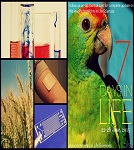 This week had some significant advancements in research domain of life science than any other domain. Now testing drugs on live animals (a process often creating confusions in results) is offered with a substitute that is using microchips having organ specific cell printed on them. Similarly, nanotechnology has blessed diabetic patients with improved insulin delivery method. In this week, scientists found that some commonly used chemicals can cause cancer if used in certain combination. More interesting discovery happened in investigation of parrots' extraordinary ability of mimicking. A disappointing news came from GM crops trails where a pheromone based GM wheat failed in field despite heavy budgeting.
This week had some significant advancements in research domain of life science than any other domain. Now testing drugs on live animals (a process often creating confusions in results) is offered with a substitute that is using microchips having organ specific cell printed on them. Similarly, nanotechnology has blessed diabetic patients with improved insulin delivery method. In this week, scientists found that some commonly used chemicals can cause cancer if used in certain combination. More interesting discovery happened in investigation of parrots' extraordinary ability of mimicking. A disappointing news came from GM crops trails where a pheromone based GM wheat failed in field despite heavy budgeting.
22 – 28 June 2015
![]()
 Pioneer pheromone oriented GM wheat failed
Pioneer pheromone oriented GM wheat failed
Project costing £732,000 or 2.8 million dollars set to develop GM wheat with capability of repelling aphids through pheromone has failed in actual cropping while it was tested significant in earlier field trails. But the researchers are not giving up instead they are trying to find out the causes of this failure. FInd source
![]()
 Next Generation of Animal Testing
Next Generation of Animal Testing
“Human cells on microchips.” Believe it or not but engineers have developed the next generation of micro-devices, printed with live human cells mimicing actual tissue functions. Scientists have recreated structures of 15 organs and believe that it can revolutionize the fate of clinical trials forever. Find source
 Instant Insulin Patch- A Smart Choice
Instant Insulin Patch- A Smart Choice
Insulin delivery in diabetics can be simplified using an automatic insulin releasing patch controlling blood glucose levels. This smart monitoring patch developed by scientists contains 121 microneedles skillfully lined with enzymatic nanoparticles that become activated at high glucose levels. Find source
 A Cancerous Cocktail of Chemicals
A Cancerous Cocktail of Chemicals
Everything we eat, drink and breathe contain chemicals that can trigger cancer in one way or another. 50 carcinogenic chemicals are identified, which were previously considered harmless. The study suggests to lower the exposure to such harmful agents surrounding the environment. Find source
 Ever wondered why Parrots can imitate?
Ever wondered why Parrots can imitate?
It’s in their brain. Parrots are recognized for their vocal imitations and great speech like sounds. Scientists have discovered the reason for speech capability of parrots. Study of their brain structure responsible for speech may also help to understand human speech phenomenon. Find source




